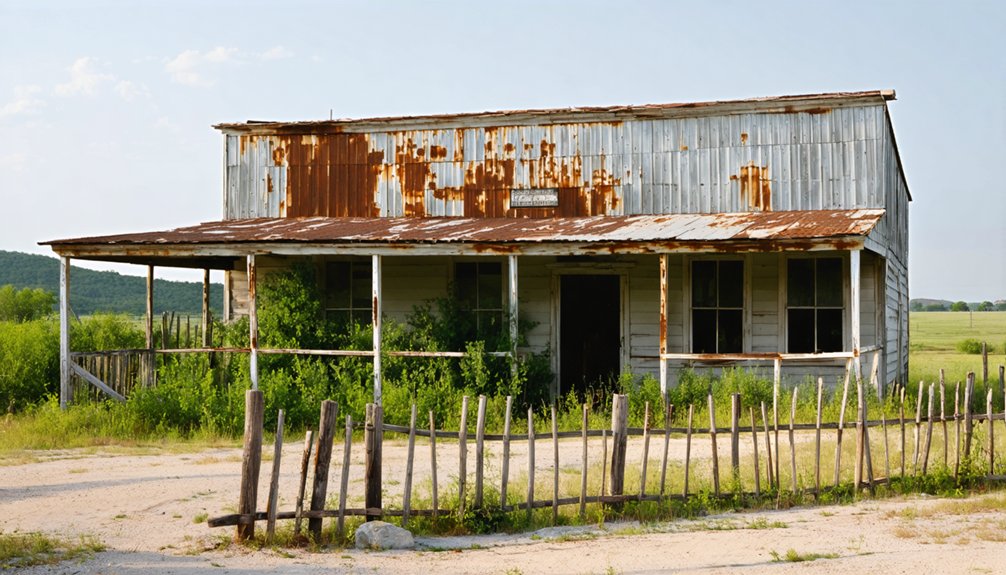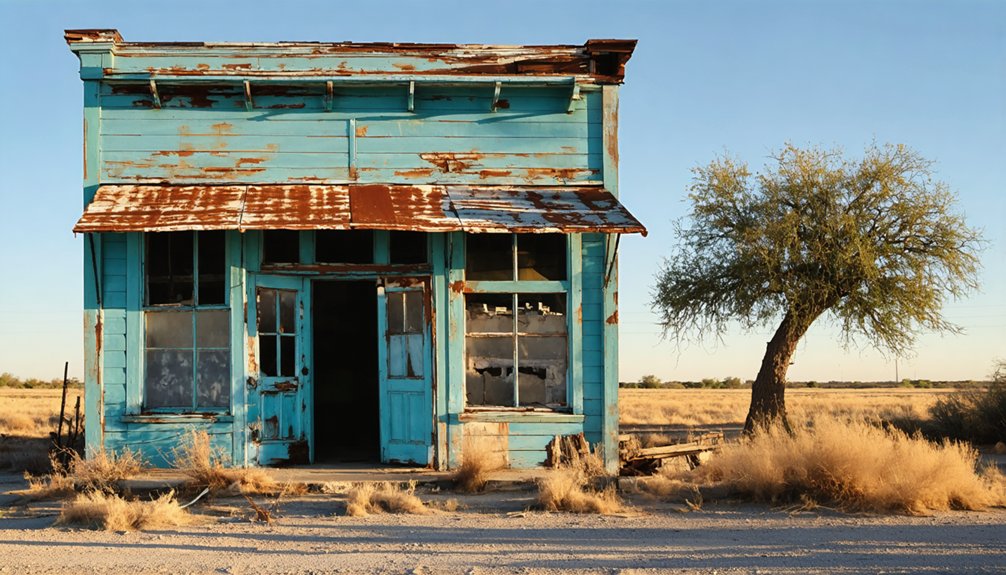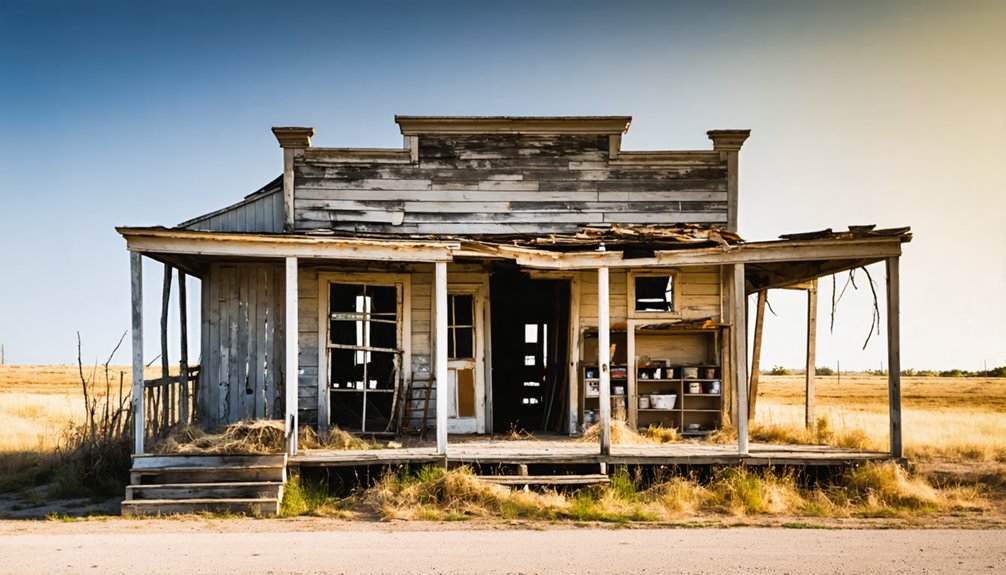You’ll find Quigley nestled in East Texas’s pine forests, where it emerged as a logging camp in 1905. The settlement thrived briefly around its sawmill operations, using traditional logging techniques and railroad transport to process timber. After closing in 1909, it experienced a short revival from 1924-1927 with a new sawmill, but economic challenges and timber depletion led to its abandonment. Today, only scattered foundation remnants lie hidden beneath the vegetation, though its story reveals much about early Texas frontier life.
Key Takeaways
- Quigley emerged in 1905 during East Texas’ logging boom, thriving as a bustling timber camp with sawmills and temporary infrastructure.
- The town’s economy relied heavily on timber, with 80% of workers dependent on the sawmill industry.
- After the sawmill’s closure in 1927, failed attempts at economic diversification led to the town’s abandonment.
- Today, only scattered foundation remnants exist, obscured by vegetation, with no standing structures or historical markers remaining.
- The site exemplifies Texas ghost towns’ boom-and-bust cycle, preserved through local folklore and county records.
The Rise of a Logging Settlement (1905-1909)
As the East Texas logging boom reached its peak in 1905, the settlement of Quigley emerged in the pine-rich forests of Jasper County. You’d have found a bustling camp where loggers wielded axes and crosscut saws, employing traditional logging techniques to harvest the region’s abundant pine forests.
The settlement’s strategic location near railroad lines proved vital for timber transportation, allowing workers to efficiently move harvested logs to broader markets. Like many historical sites documented by the Texas State Historical Association, Quigley represents an important chapter in the state’s industrial development.
Railroad access transformed Quigley from a remote logging camp into a crucial link in East Texas’s booming timber trade.
You would’ve witnessed temporary workers and seasonal crews establishing basic infrastructure – sawmills, rudimentary housing, and storage facilities essential for timber processing. Children often joined their families in the camp, with young boys performing exhausting sawmill tasks. While the camp lacked permanent institutions like schools or churches, it served its purpose as a productive logging hub.
The settlement’s sole focus on timber extraction reflected the untamed spirit of East Texas’s resource-driven economy.
A Brief Industrial Revival (1924-1927)
When timber industry investors constructed a new sawmill in Quigley during 1924, they sparked a brief but notable industrial revival in this dormant East Texas settlement.
You’ll find that sawmill operations quickly drew workers back to the area, temporarily breathing new life into the abandoned logging camp. The facility’s infrastructure included processing equipment and worker housing, enabling timber production for regional markets. Like many industrial towns of the era, workers were paid with scrip for purchases. Like the town of Plemons Crossing, Quigley’s initial growth came from its strategic business location.
But industrial challenges soon emerged. Despite initial promise, the sawmill’s activities lasted only three years before its complete removal in 1927.
Whether from depleted resources or economic pressures, the operation proved unsustainable. After the sawmill’s closure, Quigley faded from maps and historical records, marking the end of its final industrial chapter and cementing its destiny as a ghost town.
Economic Forces Behind the Town’s Decline
Quigley’s dependence on its sawmill operations made the town particularly vulnerable when lumber demand plummeted in late 1927.
You’d find that nearly 80% of the town’s workforce had direct ties to the timber industry, leaving few economic alternatives when the sawmill shuttered its operations in early 1928.
Despite attempts to attract new industries, including a short-lived cotton gin venture in 1929, Quigley’s inability to diversify its economic base ultimately sealed its fate. The town’s decline mirrors today’s struggles in Texas cities where housing values crashed, leaving once-thriving communities abandoned. The pattern of economic hardship continues in modern Texas towns like Paducah, where two-thirds of residents have left since the 1950s.
Single Industry Dependence
The extreme dependence on a single industry sealed Quigley’s economic fate, making it vulnerable to market shifts and industrial decline. You’ll find this economic vulnerability reflected in how the town’s wages, employment, and local businesses were all tightly bound to one industry’s success or failure.
When that industry stumbled, the ripple effects quickly spread throughout the community. Much like Springfield’s fateful decision to block the railroad right-of-way, this inflexibility led to devastating economic consequences. Similar patterns emerged in towns like Smiley, where having just one Dollar General highlights the lack of economic diversity.
The corporate structure’s labor control further weakened the town’s resilience. You couldn’t easily establish competing businesses or alternative employment options, as company ownership maintained a tight grip on local commerce and infrastructure.
Without economic diversity or the freedom to develop independent ventures, Quigley’s residents found themselves trapped in a system that offered little protection against market downturns or industrial collapse.
Sawmill Closure Impact
By 1909, deep-rooted issues in lumber production had converged to force the closure of Quigley’s primary economic engine – its sawmill.
You’ll find the shutdown wasn’t surprising, as the operation faced multiple critical challenges. Poor resource management had rapidly depleted local timber supplies, while larger mechanized competitors outpaced Quigley’s manual production methods. Market volatility crushed lumber prices, making sawmill sustainability impossible.
The lack of sound forestry practices accelerated the town’s downfall. As trees vanished, so did jobs and residents. This decline mirrored the fate of many small operations during the Industrial Revolution of 1840, when woodworking became a more competitive business. The Miller-Link Lumber Company eventually absorbed many of these struggling smaller operations.
The mill’s small size left it unable to invest in new technology or weather economic storms. In an era when industrial modernization determined survival, Quigley’s sawmill – trapped between resource exhaustion and technological obsolescence – simply couldn’t adapt to changing times.
Failed Economic Diversification
Following the sawmill’s closure, attempts to diversify Quigley’s single-industry economy proved futile in the face of severe infrastructural limitations.
You’ll find that the town’s isolation from major transportation networks crippled its economic resilience, making it impossible to attract new businesses or expand into emerging markets.
While neighboring towns embraced industry innovation and developed varied economic sectors, Quigley remained trapped in its timber-dependent past.
The lack of government support or private investment meant no funding for essential infrastructure improvements or workforce training programs.
Without rail connections or modern highways, you couldn’t establish viable alternative industries.
As competing towns offered better employment opportunities and modern amenities, Quigley’s workforce gradually departed, leaving behind a stark reminder of failed economic adaptation.
Geographic Features and Location Details

Located in the heart of Jasper County’s Piney Woods region of eastern Texas, Quigley emerged as a logging camp in 1905 before its abandonment just four years later.
You’ll find the ghost town nestled among dense pine forests with flat to gently rolling topographical features typical of East Texas. The area’s sandy, loamy soils supported the robust timber industry that once defined this settlement.
The site’s water accessibility played a vital role in its brief existence, with numerous creeks and streams threading through the landscape.
These waterways not only sustained the logging operations but also contributed to the region’s characteristically humid climate.
While modern highways now bypass this forgotten locale, you can still discover traces of the old rail lines and forest roads that once served this short-lived logging community.
Life in Early 20th Century Quigley
While the dense pine forests sheltered Quigley’s landscape, the town’s true character emerged from its bustling mining operations in the early 1900s.
You’d find immigrant workers from diverse backgrounds forging a tight-knit community around the Chisos Mining Company, with daily life centered on:
- The Hicks-Cobb general store, where you’d stock up on supplies and catch up on local news during community gatherings
- Essential services at the W.W. Cole Building, housing both the bank and pharmacy for your financial and medical needs
- The local post office and gas station, keeping you connected to the outside world
You’d witness families making their homes in simple workers’ housing, while men spent long days in the mines, their livelihoods rising and falling with the success of mining operations.
Legacy Among Texas Ghost Towns

As one of Texas’s numerous ghost towns, Quigley shares a familiar narrative of boom-and-bust that defined early 20th-century settlement patterns across the state.
You’ll find its story echoes those of places like Carlton and Thurber, where economic shifts and changing transportation routes spelled the end of once-thriving communities.
While Quigley’s cultural heritage might seem lost to time, it’s preserved in the broader tapestry of Texas ghost town history.
Like Toyah and Gruene, it demonstrates the community resilience that characterized these frontier settlements.
Though no specific legends surround Quigley’s remains, its silent testimony speaks to the pioneering spirit that drove Texas’s development.
Its legacy lives on as a reminder of how external forces – from technological changes to economic upheavals – can reshape the destiny of rural communities.
What Remains: Modern Site Assessment
Despite decades of abandonment, modern visits to Quigley’s original site reveal little more than scattered foundation remnants hidden beneath South Texas vegetation.
With minimal site preservation efforts and limited visitor accessibility due to private ownership, you’ll find the ghost town has largely returned to nature.
If you’re hoping to explore Quigley today, here’s what you should know:
- No standing structures remain, though you might spot faint building foundations beneath the overgrowth.
- The site lacks historical markers, interpretive exhibits, or maintained access roads.
- Private property restrictions prevent public exploration of most areas.
Unlike neighboring ghost towns that preserve historic jails or offer tourist accommodations, Quigley exemplifies the untamed fate of many small Texas settlements – quietly fading back into the landscape, protected only by local folklore and county records.
Frequently Asked Questions
Were There Any Notable Crimes or Incidents During Quigley’s Active Years?
Ever wonder about unsolved mysteries? While local legends hint at frontier violence and disputes, there’s no concrete evidence of major crimes or incidents during Quigley’s active period in the historical record.
What Happened to the Residents After They Left Quigley?
You’ll find former residents scattered across nearby towns, seeking better opportunities through rail-connected hubs. They’d take up farming, ranching, or railroad work while maintaining their community bonds through churches and civic groups.
Did Any Other Industries Attempt to Establish Themselves in Quigley?
No industry ventured into Quigley after logging ceased. You won’t find records of farming attempts or mining ventures – the town’s isolated location and depleted resources discouraged any new business development.
Are There Any Surviving Photographs of Quigley During Its Operational Period?
You won’t find any surviving photographs from Quigley’s operational days. Despite extensive archival research and searches through historic imagery collections, no authenticated pictures have been discovered in Texas repositories.
What Was the Maximum Population Reached During Quigley’s Peak Years?
Against the backdrop of Texas’ early industrial boom, you’ll find that Quigley’s population growth reached its maximum of approximately 1,052 residents during its peak years around 1910, before declining to near abandonment.
References
- https://www.youtube.com/watch?v=phjUE19A8HM
- https://mix941kmxj.com/the-strange-sad-story-of-a-texas-ghost-town-youll-never-visit/
- https://texashighways.com/travel-news/four-texas-ghost-towns/
- https://www.tshaonline.org/handbook/entries/quigley-tx
- https://en.wikipedia.org/wiki/List_of_ghost_towns_in_Texas
- https://inaroundmag.com/local/a-ghost-town-named-eureka/
- https://shilohmuseum.org/project/page/8/
- https://www2.mnhs.org/library/findaids/01162.xml?return=q=cassava
- https://archiveswest.orbiscascade.org/ark:80444/xv52062
- https://www.frick.org/sites/default/files/FindingAids/HCFCorrespondence.html



